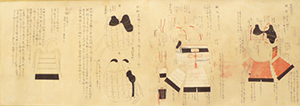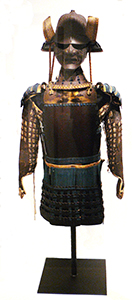The Japanese warrior is a symbol of strength, dignity, and power -- ideals reflected in warrior art. Warrior art also draws attention to traditional Japanese values such as beauty and frugality, bringing together both aesthetics and functionality.
Japanese armor emphasized both function and form. The leather, polished wood, metal, and colored cording combine to create an aesthetically pleasing covering and strong, comparatively lightweight protection perfect for hand-to-hand combat. Worn primarily for protection, face masks also reflected an artistic purpose through the depiction of characters such as monkeys and goblins, as well as more human appearances.
This scroll, as a set of instructions, indicates the importance of order, long-standing tradition and ritual practice in Japanese society. A warrior donned his armor in a specific order expressing, in the process, courage and respect.
Ukiyo-e (pictures of the floating world) became popular in the 17th century as art for townspeople, since it was inexpensive. This print pictures a famous battle from the 12th century, a popular motif during the unstable time of the 1800s.
Want to learn more about the history of the Japanese samurai?
Click the link for an interactive timeline: http://www.pbs.org/wgbh/nova/ancient/history-of-the-samurai.html

Handscroll: Treatise on Japanese Samurai Armor
Japanese, 19th century
ink on paper
Gift of Arthur E. Klauser '45, 1991.11.252
Samurai Battle
Japanese, 19th century
color woodblock print (ukiyo-e)
Gift of Arthur E. Klauser '45, 1991.11.240 a-c
This triptych represents a famous battle of 1185 -- The Night Attack on the Rokujo Horikawa Mansion -- at the end of the Heian period. Cartouches identify each of the samurai engaged in battle.

Suit of Samurai Armor
Japanese, Ashikaga Period (1338 – 1573 C.E.)
fabric, metal and mixed media
Gift of Arthur E. Klauser '45, 1991.11.159

